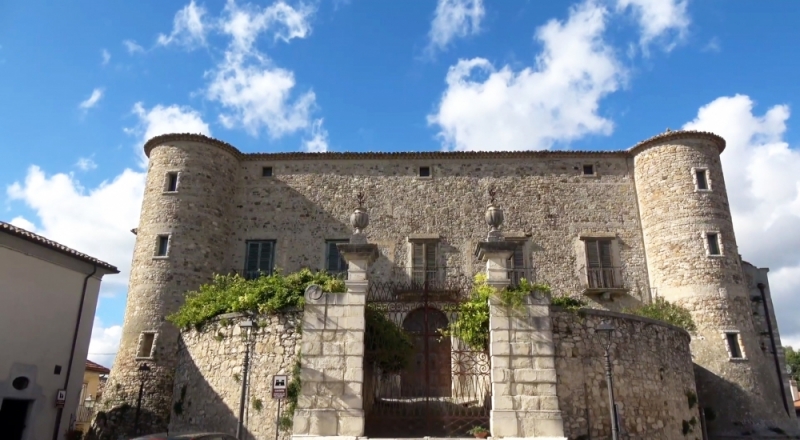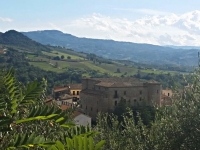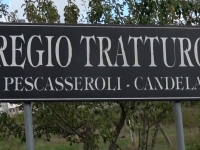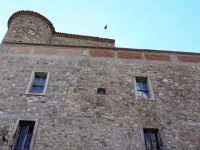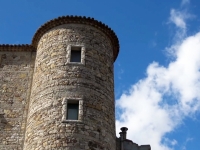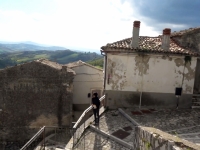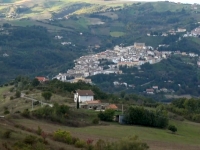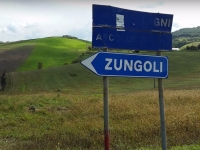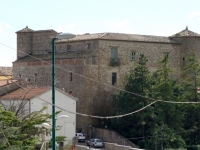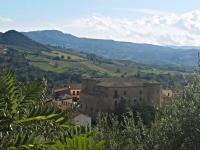The small medieval village of Zungoli (in the province of Avellino), it was built already in Roman times (as testimony of coins and tombstones) and it covered a strategic position on the Herculea (link between the important Via Appia and Via Traiana) on the border between Campania and Puglia. It is a typical Irpinia village, whose historic center is crossed by small, narrow, winding cobbled streets and stairways that climb along the ridge of the hill. The origins of the town are certainly prior to the Saracen invasions 829-983, since it appears that this country was taxed to contribute 30 men and 12 soldiers for the custody of the Crepacuore castle. The country, as we know it today, is however formed only around the year 1000, when the Normans transformed the pre-existing Byzantine Tower into a Rocca and, around the new castle, a true fortified village was created which concentrated, within its walls, the scattered population of the countryside. Of the castle, with four corner towers and placed in the highest part of the inhabited area, today some traces of the ancient walls and the 4 doors are still visible, placed at the corresponding 4 cardinal points. After the Normans the town was under the Swabian domination with Adoasio, Lord of Zungoli. From 1442 to 1500 Zungoli was under the Aragonese domination with Alfonso of Aragon who favored a great immigration. From 1513 Zungoli came under the domination of the Loffredo, Lords of Trevico and Zungoli, until the suppression of feudality. In 1618 the writer and poet Giambattista Basile was the governor of Zungoli, author of the beautiful tales "Lo Cunto de li Cunti". Today, the most important economic activities are related to agriculture and crafts related to the field of dairy products and wood, plus an interesting production of DOP Irpinia - Colline dell'Ufita extra virgin olive oil, deriving from the prized native olive "Ravece".
The center is part of the European Association of Vie Francigene as well as of the circuit of the most beautiful villages in Italy, also bearing the orange flag of the Italian Touring Club.
What see
Zungoli is worth visiting on foot, climbing up its narrow streets and stairways that climb up to the Castle.
Unfortunately, of the four cylindrical towers placed at the corners, today only three remain because one was destroyed by a strong earthquake in 1456. The façade is mighty, 30 meters long and 14 meters high. Today it is inhabited by the Marquis Susanna di Sant'Eligio. You can also see the ancient walls of the previous fortified tower on which the current castle was built. The Convent of San Francesco of the Reformed Minor Friars stands on the site where the Church of San Cataldo was originally located. Today it is divided into two levels: the lower floor, where the laboratories where wool is worked, the refectory, the kitchen and the cellars are located; and the upper one that houses the friars' cells. Several parts of the previous building are preserved: the entrance with a fresco representing the Virgin of Mount Carmel and the frescoes of the sixteenth and seventeenth centuries in the north-west rooms. Churches and noble palaces are scattered in the center of the village. The mother church of Santa Maria Assunta , rebuilt after the 1930 earthquake, contains paintings, wooden statues and an interesting baptismal font; the Church of San Nicola houses an organ and five paintings housed since 1962, the year of another earthquake; the Church of Santa Maria di Costantinopoli , abandoned by the Padri Servi di Maria following the plague in 1656, was later recovered and now houses a statue of the Madonna of Constantinople. The buildings of Annicchiarico Petruzzelli, Jannuzzi and Caputi stand out. Nearby are the two chapels of San Francesco di Paola and Sant'Antonio da Padova, and two towers, the Torre li Pizzi dating back to the Norman period and the Torre delle Ciàvole, which recurs in dark folk tales.
Climate Curiosity Tips
Climate: the temperatures are those typical of the interior of Campania and the province of Avellino. Minimum in December around the 2nd and maximum in August 27-30 °. The best times for a visit are definitely spring and September
Curiosities: Zungoli is located at 657 above sea level and the resident inhabitants are 380. The Patron Saints are Sant'Anna and San Crescenzo and are celebrated on 26 July.
Advice: The village festivals offer the rediscovery and recovery of traditions, both religious and of ancient popular / peasant beliefs. They are certainly the most important moments of the year for the country that organizes them, a moment of great conviviality to meet again (even with relatives who have emigrated abroad) and relive ancient customs, reaffirming the genuine flavors of rural civilization. This is true here in Zungoli as everywhere there is a village festival. In particular, in this village uncontaminated pastures and traditional farms guarantee the authenticity of tasty lamb, rabbit, chicken and pork dishes. But the cheeses are also delicious, caciocavalli, soppressate, capicollo, ham, sausages, still prepared by hand as in the past. Among the typical dishes emerge: Fusilli prepared by hand, Polenta and mushrooms, Cavatelli and broccoli, Terracotta saucepan, La cianfotta. To mention the excellent quality of the oil produced in the village from the San Comaio farm and the excellent local Caciocavalli produced with milk from the Podolica breed of cow.


